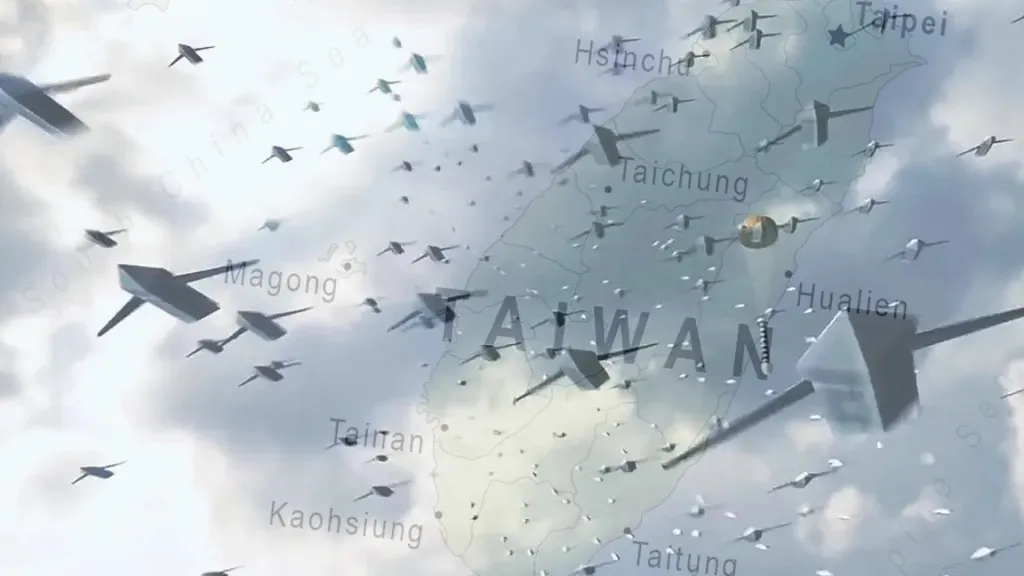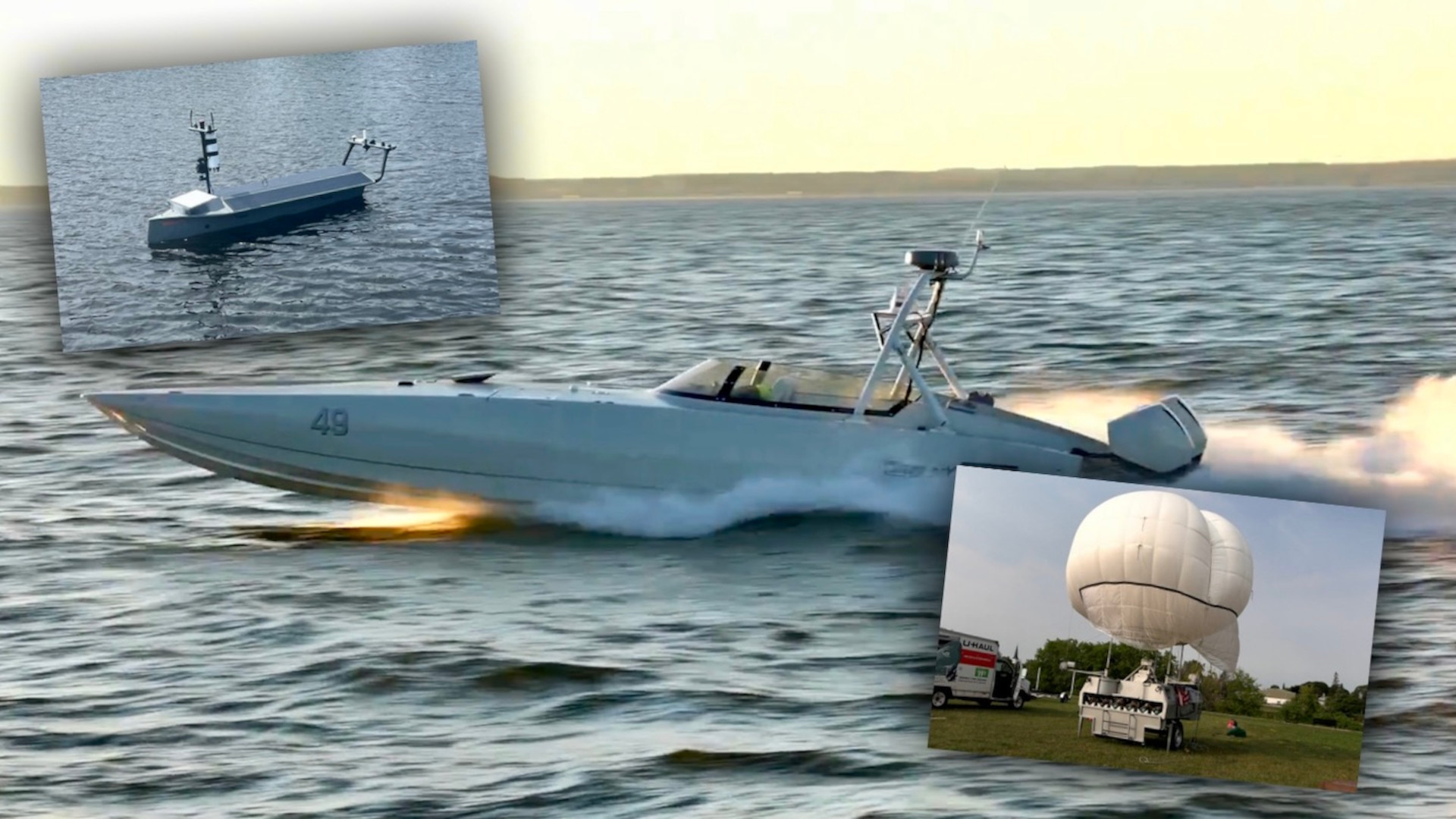Earlier this month, the U.S. Navy experimented for two weeks with uncrewed aerial systems and drone boats which could be used for launching swarming electronic warfare attacks, and more, in future conflicts. Dubbed Silent Swarm 2024, the event was designed to test early-stage electronic spectrum technology offerings from industry.
Held at the Alpena Combat Readiness Training Center (CRTC) in Alpena, Michigan, the test event ran from July 15 to 26. It was hosted by the Navy’s Surface Warfare Center, Crane Division (NSWC Crane) in partnership with the Michigan National Guard, Naval Information Warfare Center Atlantic Division, National Oceanic and Atmospheric Administration, Army C5ISR Center, and the Air Force Test Center. Sponsorship was provided by the Office of the Under Secretary of Defense for Research and Engineering, Integrated Sensing and Cyber. Silent Swarm 2024 is the third iteration of the exercise, with the first taking place in 2022.
Over 500 participants from across the civilian and military spheres were involved in the testing at Alpena. Industry participants included L3Harris Technologies, Anduril Industries, Silvus Technologies, G3 Technologies, Starlink, and Northrop Grumman, among others. Companies were able to gain real-time feedback from civilian experts as well as representatives from the U.S. Air Force, Army, Coast Guard, Marine Corps, and Navy on their offerings.
Images released by small boat manufacturer Seasats show several of its uncrewed surface vessels (USVs) kitted out with payloads designed by the above manufacturers. Moreover, Northrop Grumman also released video footage from the event showing the integration of USVs and uncrewed aerial vehicles (UAVs) with different payload configurations.
“We bring folks here, technologies from industry, government labs, and academia, all focused on a central hypothesis that small electromagnetic spectrum operations… employed on small, multi-domain unmanned systems can have a really beneficial impact for our deployed forces,” Rob “Ice” Gamberg, Silent Swarm lead and fleet experimentation lead for NSWC Crane, said.
While specific details on the offerings experimented with during the two weeks remain limited, we know that over 57 technologies were demonstrated. “You have technologies out there, you have those unmanned surface vessels, the boats, out there, that one company [Seasats] has brought, and that’s cool… but it’s even more interesting when you can put a sensor on it… and then they deploy 10 of them, with sensors, and then they can really surround an area, and just the impact that can have, and the ability to feed that information back to other sources,” Sondra Laughlin, deputy lead for Silent Swarm, noted. “We do a lot of networking, as much as we can, throughout the entire process.”
The technologies were tested within an “operationally-relevant sandbox environment,” which included “land, air, sea, undersea, cyber, and space.” According to the Department of Defense, Silent Swarm 2024 specifically focused on the evaluation of “technologies
for enhanced sensing, precision navigation and timing (PNT), delivery and resilience to non-kinetic effects, autonomy and electronic warfare enabled cyber operations for both autonomous and semi-autonomous operations.”
“We bring in new technologies, we create an environment where they [industry] can bring those technologies in and experiment with them,” Gamberg noted. “[We] try new things — succeed, fail, learn.”
A more detailed outline of the criteria against which the technologies would be tested during the exercise was provided by Naval Sea Systems Command last year, although it’s unclear if this was followed precisely.
1. Distributed Electromagnetic Attack (EA): Delivery of electromagnetic energy to include high-power microwave to deny, degrade, disrupt, & deceive an adversary’s capabilities via high-mobility platforms. EA effects from many small autonomous vehicles carrying low-cost jammers & smart sensors. Utilize distributed reactive EA assets to hinder adversary spectrum sensing.
2. Deception: Distributed capabilities to create chaos & confusion in the spectrum through RF means. Targeting adversary situational awareness, command & control, & decision-making processes to enable friendly force freedom of maneuver. Deny adversary ability to maintain an accurate picture of the operational environment. Use distributed, low-observable deception devices to obscure, give false targets, & clutter.
3. Digital Payload Delivery: Digital capabilities that can be used in support of electromagnetic spectrum operations (EMSO). Capabilities that contribute to blinding, seeing, or targeting the adversary by degrading their ability to utilize the electromagnetic spectrum & their ability to share information over tactical edge networks. Deny adversary ability to maintain an accurate picture of the operational environment.
The Navy has been heavily investing in an entire distributed, networked, cooperative electronic warfare ecosystem for years now. The broad effort extends across domains, including ship-mounted systems like the AN/SLQ-32(V)7 Surface Electronic Warfare Improvement Program Block III (SEWIP Block III) and podded capabilities for aircraft like the AN/ALQ-248 Advanced Off-Board Electronic Warfare (AOEW) system. There is also a heavy emphasis on uncrewed systems, including expendable types to help lure away threats, such as the Long Endurance Electronic Decoy (LEED). Referred to in part in the past as the Netted Emulation of Multi-Element Signature against Integrated Sensors, or NEMSIS, which The War Zone was the first to report on, the work collectively represents a major leap forward in electronic warfare capabilities.

The 2024 iteration of Silent Swarm also builds on the findings from the previous two iterations of the event. “[Silent Swarm]… started as a small, unmanned table top exercise in December of 2021, focusing on kinetic warfare,” Gamberg noted previously. “We started bringing in more EW [electronic warfare] capabilities and saw it had significant impact — so we thought, ‘If it works well in a wargame, how can we bring it out into the battlefield?’”
“Our event has grown each year over the last three years,” Gamberg notes. “Initially, the first year [2022], we had 17 technologies that we brought up,” with around 150 people in attendance. The 2023 iteration then showcased some 31 technologies, with 300 people in attendance.
In addition to small UAVs and USVs, last year’s iteration of Silent Swarm also featured balloons roughly 20 feet in diameter for experimentation with long-distance communications.

Whether or not the Navy ultimately ends up procuring any of the technologies — or derivatives thereof — explored during the most recent Silent Swarm exercises remains to be seen. However, the service stresses that the results from Silent Swarm 2024 will help to “improve spectrum maneuver and resilience capabilities for military personnel.”
Broadly, the Navy has shown increasing levels of interest in drone technologies — in terms of both UAVs and USVs — in recent years. Smaller types which the service is either using, or extremely interested in, could well be networked together into highly autonomous swarms of the kind experimented with during Silent Swarm 2024.
For example, in May the Navy established its second Unmanned Surface Vessel Squadron (USVRON) at Naval Amphibious Base Coronado. At that time, USVRON-3 received the first four of what are expected to be “hundreds” of small USVs that will eventually deploy and operate with the surface force’s guided-missile destroyers.

Swarms of these kinds of drones, armed with various electronic warfare technologies, would be critical in a potential future conflict in the Pacific, likely involving China. Wargames conducted by the U.S. military in the past have underlined the value of swarms of relatively low-cost drones networked together; particularly during simulations of the defense of Taiwan against a Chinese invasion.
At the broader level, INDOPACOM already has plans to turn the airspace and waters around Taiwan into a “hellscape” should China invade it. This would involve using masses of uncrewed platforms to “turn the Taiwan Strait into an unmanned hellscape using a number of classified capabilities,” Navy Adm. Samuel Paparo, INDOPACOM’s top officer, revealed on the sidelines of the annual Shangri-La Dialogue in Singapore earlier this year, “so that I can make their lives utterly miserable for a month, which buys me the time for the rest of everything.”

Given the urgency with which the Navy expects to need such capabilities in the near future, it’s unlikely the wait will be long to see which technologies experimented with at Silent Swarm 2024 will be adapted for combat use.
Contact the author: oliver@thewarzone.com
